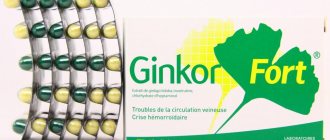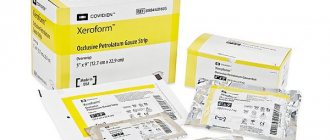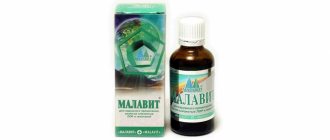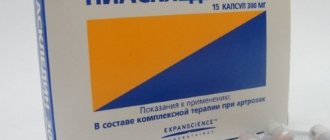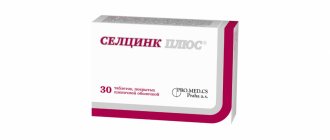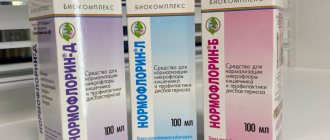Composition of Aerovit
Aerovit (1 tablet) contains 100 mg ascorbic acid, 20 mg acetate α-tocopherol, 10 mg calcium pantothenate, 10 mg pyridoxine hydrochloride, 15 mg nicotinamide, 2 mg riboflavin mononucleotide, 6600 IU retinol acetate, 50 mg rutoside, 200 mcg folic acid, 2 mg thiamine hydrochloride, 25 mcg cyanocobalamin.
Reviews
Numerous positive reviews from patients and specialists confirm the effectiveness of Aerovit. The drug is prescribed in the presence of vitamin deficiency, exhaustion of the body, as well as to maintain and improve the performance of its vital functions. The vitamin complex is recommended for use if you are prone to colds, during the recovery period after operations and infections, as well as the consequences of other negative factors.
If you have experience taking this vitamin complex, be sure to share it with other site visitors.
Pharmacodynamics and pharmacokinetics
The effect of the drug Aerovit is due to the effects of the substances included in its composition.
B vitamins regulate the metabolism of carbohydrates, lipids and proteins in the body and have a multivitamin effect.
Thiamine is necessary for transmitting impulses along axons in all tissues and the nervous system; as a coenzyme, it is involved in carbohydrate metabolism.
Riboflavin is a catalyst for cellular respiration processes and peroxidation reactions.
Pyridoxine as a coenzyme is involved in the metabolism of amino acids and proteins, in the biosynthesis of neurotransmitters.
Cyanocobalamin and folic acid stimulate the synthesis of nucleotides, participate in the formation of red blood cells and nerve sheath structures, and are also necessary for normal growth of the body.
Retinol is involved in the biosynthesis of various substances ( proteins, lipids, mucopolysaccharides ) and ensures the function of the skin, mucous membranes and organs of vision.
Tocopherol is involved in the processes of cell division, in the biosynthesis of proteins and hemoglobin , the functioning of blood vessels, skeletal muscles, gonads, and heart.
Ascorbic acid helps the oxidation of a number of active substances, normalizes connective tissue, carbohydrate metabolism, blood , activates the formation hormones , and improves capillary permeability.
Rutin is involved in redox reactions, has antioxidant properties, stops oxidation and helps preserve vitamin C in tissues.
Nicotinamide stimulates tissue respiration, lipid and carbohydrate metabolism, and xenobiotic metabolism.
Pantothenic acid is a component of coenzyme A , improves the processes of oxidation and acetylation, participates in carbohydrate and lipid metabolism, the biosynthesis of acetylcholine and some hormones.
Aerovit normalizes metabolism , has a tonic effect, and increases intellectual and physical performance.
Side effects
A side effect of taking Aerovit can be an allergic reaction in the form of rashes of various locations. This condition is a consequence of improper use of the drug (if there are contraindications).
Side effects may be accompanied by uncontrolled use of the vitamin complex, but the negative symptoms will be different.
Overdose
The intensity of the symptoms of an Aerovit overdose may vary depending on the individual characteristics of the body. A negative reaction appears immediately after exceeding the prescribed dosage or when it is regularly overestimated. The need to discontinue the vitamin complex will be indicated by drowsiness, nausea, general weakness of the body, or paleness of the skin.
Features of overdose:
- negative symptoms are eliminated by symptomatic treatment;
- after identifying the fact of an overdose, it is necessary to conduct an examination, including a biochemical blood test.
Contraindications
Aerovit is not used in pediatric practice. Ages under eighteen years are an absolute contraindication for the drug. Some components of the vitamin complex may cause individual intolerance. Increased sensitivity can be detected through a preliminary examination by a specialist.
The following conditions are contraindications for taking the vitamin complex:
- individual intolerance;
- period of pregnancy and lactation;
- taking certain medications.
During pregnancy
Aerovit is prohibited from use during pregnancy, regardless of the period. The preparation contains a large amount of vitamin A and a high concentration of other components. This combination can disrupt the process of fetal formation and have a negative effect on it. A similar ban applies to the period of lactation.
During pregnancy and breastfeeding, it is recommended to give preference to vitamin complexes developed specifically for these periods.
Analogs
Level 4 ATC code matches:
Makrovit
Tetravit
Decamevit
Gendevit
Sana-Sol
Hexavit
Revit
Vitasharm
Pikovit Forte
Pikovit
Vetoron for children
Vetoron E
Vetoron
Angiovitis
Undevit
Vitrum Performance
Pentovit
Alvitil, Antioxycaps, Angiovit, Beviplex, Vetoron, Benfolipen, Vitabex, Vitacitrol, Vitasharm, Pentovit, Pikovit, Vitamult, Hexavit, Decamevit, Gendevit, Jungle, Kvadevit, Makrovit, Kaltsevita, Neurogamma, Multivita plus, Neuromultivit, Pangexavit, Neurotrat forte, Polivit Baby, Polybion N, Tetravit, Rikavit, Undevit, Revit, Unigamma, Foliber, Unicap V.
Indications for the use of Aerovit vitamins
Aerovit vitamins have a rich composition. It contains those microelements that a person needs every day.
The main indication for the use of Aerovit vitamins is the lack of nutrients or their complete absence in the body. This condition is usually observed with the following pathologies and phenomena:
- cachexia - exhaustion of the body;
- parasitic infection of the intestinal canal;
- inflammatory or somatic diseases of the digestive system;
- starvation;
- poor nutrition.
In addition, the dietary supplement is recommended for those people who are regularly exposed to extreme factors such as low barometric pressure, noise, vibration, overload and motion sickness.
The drug is necessary to maintain the body's defenses. It will increase immunity for those patients who have chronic diseases or have undergone surgery.
Precautionary measures
Aerovit vitamins cannot be taken simultaneously with other medications. This can lead to hypervitaminosis.
Before using a dietary supplement, you need to study the instructions and exclude any contraindications.
Vitamin B6 helps reduce the antiparkinsonian effect of levodopa and the effectiveness of steroid hormonal drugs.
Important! The nutritional supplement is available without a doctor's prescription.
Tablets should be stored at room temperature in their original containers. The drug is valid for 24 months from the date of manufacture.
Areplivir (favipiravir)
Registration number:
LP-006288
Trade name:
AREPLIVIR
International nonproprietary or generic name: favipiravir Dosage form: film-coated tablets
Compound
for 1 tablet:
- Active substance:
- Favipiravir - 200.0 mg
- Excipients:
- Povidone (K-30), colloidal silicon dioxide, low-substituted hyprolose, microcrystalline cellulose (type 101), crospovidone, stearic acid.
Film casing:
Ready-made film coating Opadry® 03F220114 yellow [Hypromellose, titanium dioxide, macrogol 4000 (Polyethylene glycol 4000), yellow iron oxide dye E172].
Description:
The tablets are round, biconvex, film-coated, light yellow in color. On a cross section, the core is white or almost white.
Pharmacotherapeutic group:
antiviral agent
ATX code: J05AX27
Pharmacodynamics
Antiviral activity in vitro
Favipiravir has antiviral activity against laboratory strains of influenza A and B viruses (half maximum effective concentration (EC50) 0.014-0.55 μg/ml).
For strains of influenza A and B viruses resistant to adamantane (amantadine rimantadine), oseltamivir or zanamivir, the EC50 is 0.03-0.94 µg/ml and 0.09-0.83 µg/ml, respectively. For influenza A virus strains (including strains resistant to adamantane, oseltamivir and zanamivir), such as swine influenza type A and avian influenza type A, including highly pathogenic strains (including H5N1 and H7N9), the EC50 is 0.06-3 .53 µg/ml.
For strains of influenza A and B viruses resistant to adamantane, oseltamivir and zanamivir, the EC50 is 0.09-0.47 μg/ml; cross-resistance is not observed.
Favipiravir inhibits the SARS-CoV-2 virus, which causes novel coronavirus disease (COVID-19). The EC50 in Vero E6 cells is 61.88 µmol, which corresponds to 9.72 µg/ml.
Mechanism of action
Favipiravir is metabolized in cells to favipiravir ribosyl triphosphate (favipiravir RTP) and selectively inhibits RNA-dependent RNA polymerase involved in influenza virus replication. Favipiravir RTF (1000 µmol/L) showed no inhibitory effect on human α DNA, but showed an inhibitory effect ranging from 9.1 to 13.5% on β and ranging from 11.7 to 41.2% on human γ DNA . The inhibitory concentration (IC50) of favipiravir PTF for human RNA polymerase II was 905 μmol/L.
Resistance
After 30 subcultures in the presence of favipiravir, no changes were observed in the susceptibility of influenza A viruses to favipiravir, and no resistant strains were observed. Clinical studies have not revealed the emergence of influenza viruses resistant to favipiravir.
Pharmacokinetics
Suction
Favipiravir is easily absorbed from the gastrointestinal tract. Time to reach maximum concentration (Tmax) 1.5 hours.
Distribution
Plasma protein binding is about 54%.
Metabolism
Favipiravir is primarily metabolized by aldehyde oxidase and partially metabolized to its hydroxylated form by xanthine oxidase. Favipiravir RTF is metabolized in cells. Of the other metabolites, in addition to hydroxylate, glucuronate conjugate was also recorded in human blood plasma and urine.
Removal
Favipiravir is primarily excreted by the kidneys as the active hydroxylate metabolite, with a small amount unchanged. The half-life (T1/2) is about 5 hours.
Patients with liver dysfunction
When favipiravir was administered to patients with mild to moderate hepatic impairment (Child-Pugh class A and B), Cmax and AUC increased by 1.5 times and 1.8 times, respectively, compared to healthy volunteers. These increases in Cmax and AUC for patients with severe hepatic impairment (Child-Pugh class C) were 2.1 times and 6.3 times, respectively.
Patients with impaired renal function
In patients with moderate renal impairment (GFR <60 mL/min and ≥30 mL/min), the trough concentration of favipiravir (Cthrough) increased 1.5-fold compared to patients without renal impairment. The drug has not been studied in patients with severe and terminal renal failure (GFR <30 ml/min).
special instructions
If a side effect develops, it is necessary to report this in the prescribed manner for the implementation of pharmacovigilance activities.
Because fetal death and teratogenicity were observed in animal studies with favipiravir, AREPLIVIR should not be administered to pregnant or suspected pregnant women.
- When prescribing AREPLIVIR to women capable of childbearing (including those less than 2 years postmenopausal), it is necessary to confirm a negative pregnancy test result before starting treatment. Women of childbearing potential should be fully explained the risks and carefully instructed to use the most effective method of contraception with their partners while taking the drug and for 1 month afterwards (condom with spermicide). If you suspect a possible pregnancy, you should immediately stop taking the drug and consult your doctor.
- When distributed in the human body, favipiravir enters the semen. When prescribing the drug to male patients, the risks should be fully explained and carefully instructed to use the most effective methods of contraception during sexual intercourse while taking the drug and for 3 months after its end (condom with spermicide). Additionally, male patients should be instructed not to have sexual contact with pregnant women.
- When distributed in the human body, favipiravir passes into breast milk. When prescribing the drug, breastfeeding women should be fully explained the risks and carefully instructed to stop breastfeeding while taking the drug and for 7 days after it ends.
Impact on the ability to drive vehicles and machinery:
Care should be taken when driving vehicles and operating machinery.
Release form:
Film-coated tablets, 200 mg.
10 tablets per blister pack made of polyvinyl chloride film and printed varnished aluminum foil or polyvinyl chloride/polyvinylidene chloride film and printed varnished aluminum foil.
40, 100 tablets per jar made of high-density polyethylene, sealed with a polypropylene lid with first-opening control. The free space in the jar is filled with medical hygroscopic cotton wool.
Each jar or 4 blisters along with instructions for medical use are placed in a cardboard pack.
Storage conditions
At a temperature not exceeding 25 ºС in secondary packaging.
Keep out of the reach of children.

